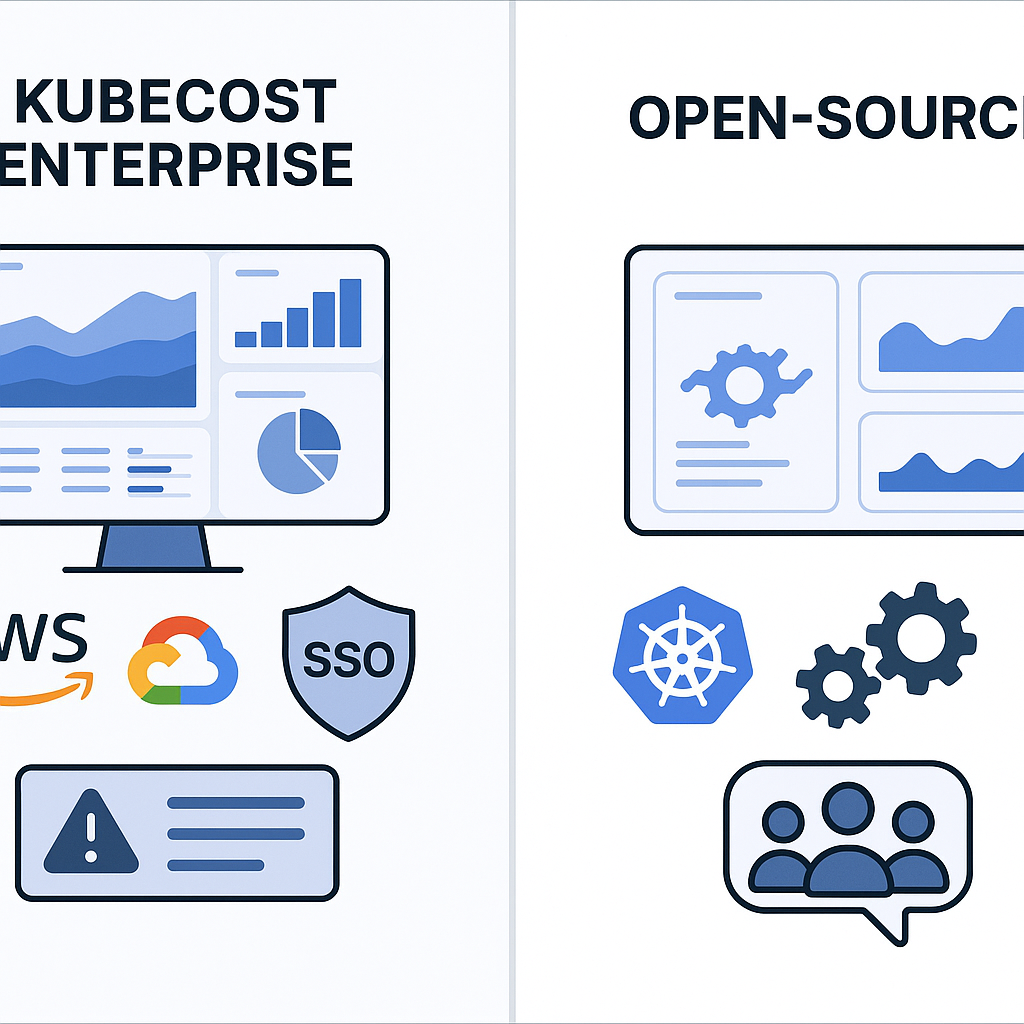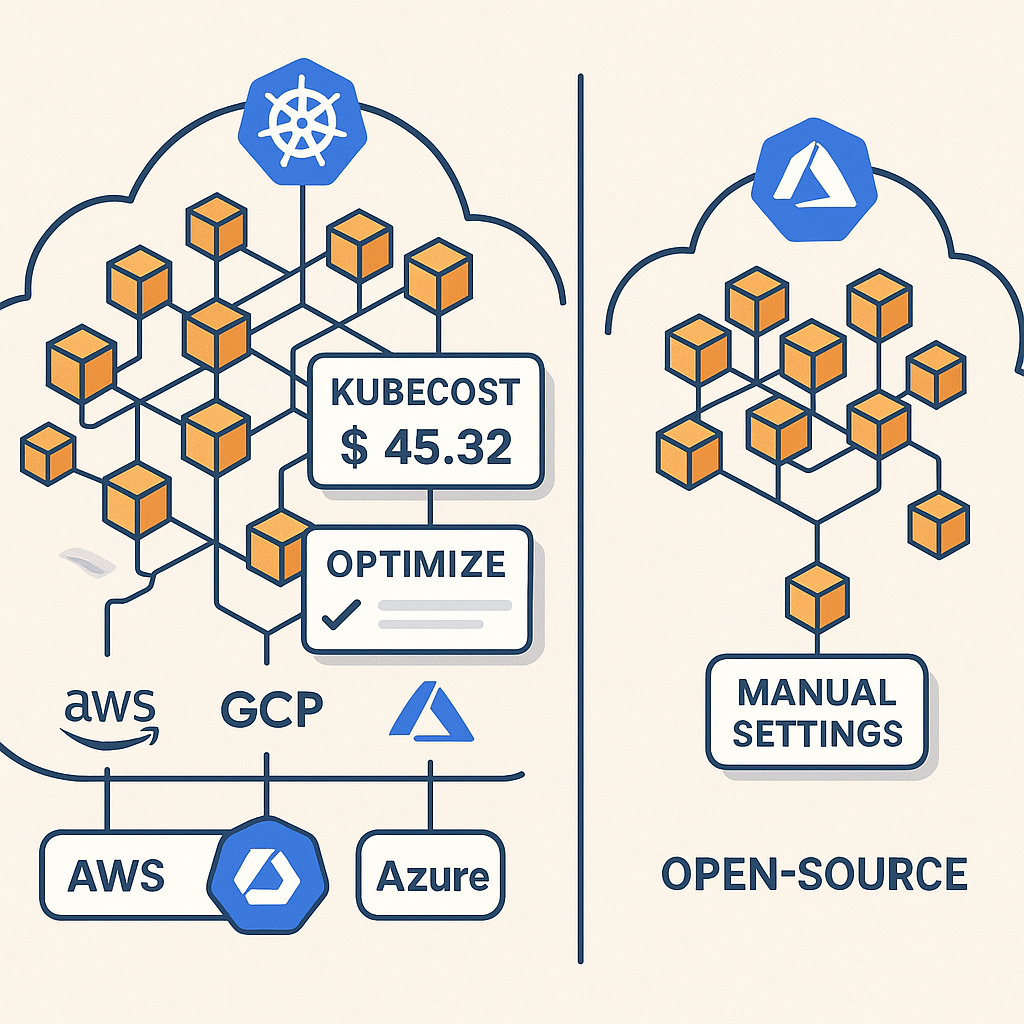Kubecost Enterprise versus Open Source: Key Differences and Pricing Insights
Are your Kubernetes costs spiraling out of control? Without proper visibility into container-level spending, organizations typically overprovision resources by 30-50%, leading to unnecessary cloud expenses. As Kubernetes environments grow in complexity, choosing the right cost management solution becomes critical for IT teams seeking to optimize cloud spending.
This comparison explores how Kubecost Enterprise stacks up against open-source alternatives, helping you determine which option best aligns with your organization’s needs for Kubernetes cost monitoring and optimization.

What is Kubecost?
Kubecost provides visibility into Kubernetes spending across deployments, helping organizations monitor, manage, and optimize their cloud costs. The platform comes in two primary versions:
- Kubecost Enterprise - A comprehensive paid solution with advanced features
- Open-source options - Including OpenCost and the free tier of Kubecost
Think of Kubecost as your financial analyst for Kubernetes - it examines where your cloud budget is going and identifies opportunities to eliminate waste without sacrificing performance.
Feature Comparison: Kubecost Enterprise vs. Open-Source Alternatives
Cost Allocation Capabilities
Kubecost Enterprise:
- Granular tracking at pod, deployment, service, and namespace levels
- Real-time cost allocation across all resources
- Custom pricing support for specialized environments
- Unified multi-cluster views for centralized monitoring across your entire infrastructure
Open-source alternatives:
- Basic container-level cost visibility
- Limited cross-cluster aggregation
- Support for on-prem environments via custom pricing sheets
- Generally suitable for smaller deployments
For complex organizations, the difference is similar to comparing a household budget app versus enterprise financial management software - both track spending, but at vastly different levels of detail and scope.
Multi-Cloud Support and Integrations
Kubecost Enterprise:
- Unified cost insights across AWS, GCP, and Azure
- Advanced integrations with SSO/SAML for enterprise security requirements
- Long-term storage via object storage for historical analysis
- Seamless integration with Prometheus and Grafana for comprehensive observability
Open-source alternatives:
- Basic cloud provider support
- Community-driven integrations
- Manual metric retention management
- Relies on open-source tooling ecosystem
The enterprise version provides a consolidated “single pane of glass” for all cloud environments, while open-source options typically require more configuration and manual correlation between platforms.
Optimization Capabilities
Kubecost Enterprise:
- Automated rightsizing recommendations
- Idle resource identification
- Real-time optimization insights for 30-50%+ cost savings
- Anomaly detection and alerting
Open-source alternatives:
- Basic utilization metrics
- Limited optimization recommendations
- Requires manual configuration and analysis
- Tools like Karpenter can complement for auto-scaling
In real-world terms, enterprise tools proactively suggest specific actions to save money, while open-source options provide the data but leave the analysis and decision-making to your team.
Pricing Comparison
The cost difference between Kubecost Enterprise and open-source alternatives is significant:
Kubecost Enterprise:
- Subscription-based pricing (contact vendor for specific pricing)
- Enterprise-grade SLAs and support
- Higher upfront investment
- Potential for greater ROI through advanced optimization features
Open-source alternatives:
- Free or low-cost tiers available
- Community support (no SLAs)
- Additional costs for infrastructure to host the solution
- Engineering time required for setup and maintenance
Total Cost of Ownership Considerations
When evaluating TCO, consider these factors beyond the initial price:
Kubecost Enterprise:
- Dedicated support reduces troubleshooting time
- Pre-built dashboards minimize setup effort
- Scalability for large deployments
- Automated optimization potentially delivering greater savings
Open-source tools:
- No licensing fees
- Engineering effort required for setup/optimization
- Potential integration challenges
- Limited scalability for complex environments
The true cost equation must factor in both direct costs (licensing) and indirect costs (engineering time, infrastructure, opportunity cost of delayed optimizations).

Real-World Cost Savings
Both options have demonstrated significant cost reductions in production environments:
-
A global e-commerce company achieved 35% cost reduction using a combination of Karpenter auto-scaling and Kubecost visibility tools, according to Hykell’s research on open-source cloud cost management.
-
Organizations using Kubecost Enterprise report 30-50%+ savings through automated optimization recommendations.
-
Hykell customers implementing automated optimizations for EC2, EBS, and Kubernetes report savings of up to 40% on AWS without ongoing engineering effort.
These case studies demonstrate that proper cost management isn’t just about visibility—it translates directly to tangible financial benefits.
Which Solution is Right for Your Organization?
Kubecost Enterprise may be better if you:
- Manage complex multi-cloud Kubernetes environments
- Require enterprise-grade support with SLAs
- Need unified visibility across multiple clusters
- Value time savings from pre-built dashboards and automated recommendations
- Have limited internal engineering resources for cost optimization
Open-source alternatives may be better if you:
- Operate smaller Kubernetes deployments
- Have strong technical teams comfortable with configuration
- Prioritize cost-effectiveness over advanced features
- Need customizable solutions for specific requirements
- Work primarily in on-premises environments
Key Considerations for Decision-Makers
When selecting between Kubecost Enterprise and open-source options, evaluate:
- Scale of operations - Larger deployments typically benefit more from Enterprise features
- Technical capabilities - Open-source requires more hands-on management
- Budget constraints - Balance licensing costs against potential savings
- Support requirements - Determine if community support is sufficient
- Integration needs - Consider existing tooling and infrastructure
Think of it as choosing between leasing a fully-maintained vehicle (enterprise) versus buying and maintaining your own (open-source)—the right choice depends on your specific circumstances and resources.
The OpenCost vs. Kubecost Question
OpenCost and Kubecost have an interesting relationship. OpenCost is a CNCF sandbox project that provides foundational Kubernetes cost monitoring capabilities. Kubecost builds upon this foundation with additional features in both its free and enterprise tiers.
The key differences:
- OpenCost focuses solely on cost allocation with vendor-neutral, open-source principles
- Kubecost offers a broader feature set including optimization recommendations and advanced integrations
According to CloudZero’s comparison, “OpenCost is vendor-neutral and integrates with open-source tooling,” while Kubecost provides more comprehensive enterprise capabilities.
This distinction is important for organizations that prioritize vendor neutrality or have specific integration requirements with their existing open-source ecosystem.
Alternative Approach: Managed Cost Optimization
For organizations seeking to minimize engineering effort while maximizing savings, managed cost optimization services like Hykell provide an alternative approach. Hykell specializes in automated AWS cost optimization, delivering up to 40% cloud savings without requiring ongoing internal engineering resources.
Their pay-for-performance model means you only pay a percentage of actual savings achieved, aligning incentives and eliminating upfront investment risks. This approach is particularly valuable for teams that:
- Want to focus engineering resources on core business initiatives rather than cost management
- Need to demonstrate immediate ROI from optimization efforts
- Lack specialized knowledge in cloud cost optimization techniques
- Have complex AWS deployments including Kubernetes, EC2, and EBS resources
Take the Next Step
Understanding your Kubernetes costs is essential for cloud financial management. Whether you choose Kubecost Enterprise for its comprehensive features or an open-source alternative for flexibility and cost-effectiveness, implementing proper cost monitoring will provide the visibility needed to make informed optimization decisions.
Consider your organization’s specific requirements, technical capabilities, and budget constraints when selecting the right solution. For many organizations, the investment in a more robust solution pays dividends through greater cost savings and reduced management overhead.
For AWS-focused organizations seeking to optimize Kubernetes costs without dedicating internal resources, explore how Hykell’s automated optimization can deliver significant savings with minimal effort.
